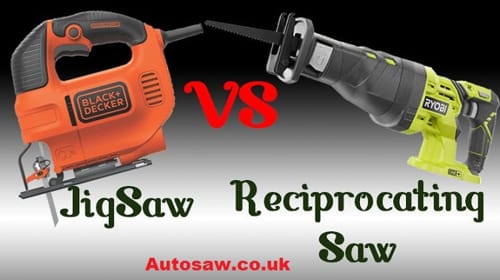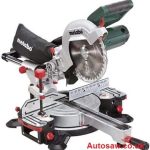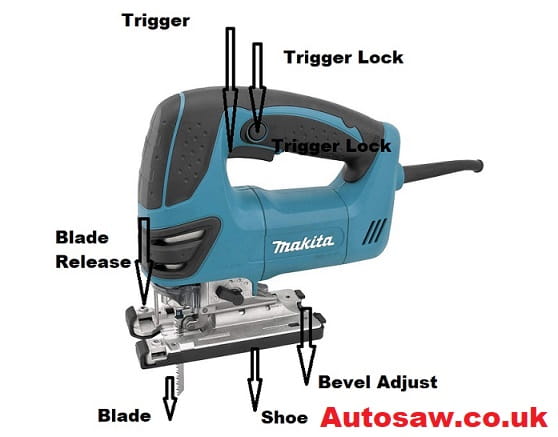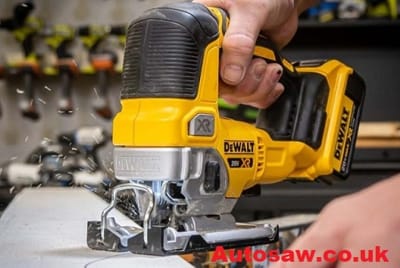As an Amazon Associate, I earn from qualifying purchases.

When it comes to choosing the right saw for your needs, it can be tricky to decide between a jigsaw and a reciprocating saw. Both saws have their own unique advantages and disadvantages, so it’s important to know what each one is best suited for before making a decision.
Jigsaws are great for making curved or irregular cuts, and they’re also fairly easy to control. However, they can be a bit slower than reciprocating saws and may not be able to handle tougher materials as easily.
Reciprocating saws, on the other hand, are much faster and can easily handle tougher materials. However, they can be a bit more difficult to control, making them better suited for straight, clean cuts.
Jigsaw vs Reciprocating Saw: Which is Better for You?
There are a lot of different types of saws on the market these days, and it can be tough to decide which one is right for your needs. Two of the most popular options are jigsaws and reciprocating saws, but how do you know which one is better for you? Let’s take a closer look at the two types of saws and see which one comes out on top.
Jigsaws are great for making curved or intricate cuts, and they can be used on a variety of materials. They’re also relatively lightweight and easy to maneuver, making them a good option for projects that require a lot of detail work.
Reciprocating saws, on the other hand, are better suited for making straight, rough cuts. They’re much more powerful than jigsaws and can handle tougher materials, making them a better choice for demolition work or other heavy-duty tasks. They’re also usually more expensive than jigsaws, so keep that in mind when making your decision.
So, which type of saw is better for you? If you need to make detailed, precise cuts, a jigsaw is the way to go. If you’re looking for a powerful saw that can handle tougher materials, a reciprocating saw is the better option.
Jigsaw: Pros and Cons
A jigsaw is a type of power saw that uses a reciprocating blade to cut curves and irregular shapes in wood, metal, or other materials. Jigsaws are relatively small and lightweight, making them easy to control with one hand.
One of the biggest advantages of a jigsaw is its versatility. It can be used to make straight cuts, curved cuts, and even to cut out complex shapes. Jigsaws can also be used to create intricate designs in wood, metal, or other materials.
Another advantage of a jigsaw is that it is relatively easy to use. Even beginners can learn how to use a jigsaw with a little practice. Jigsaws are also relatively safe to use, as long as you follow the safety instructions that come with the saw.
The biggest disadvantage of a jigsaw is that it can be difficult to make straight cuts. If you are not careful, the blade can wander off the line you are trying to cut. This can be frustrating for beginners, and it can be difficult to fix once the cut is made.
Another disadvantage of a jigsaw is that it can be difficult to control the speed of the blade. If the blade is moving too fast, it can cause the material to splinter or break. If the blade is moving too slowly, it can cause the material to melt or distort.
Reciprocating Saw: Pros and Cons
The reciprocating saw is a versatile tool that can be used for a variety of projects. It is a powerful tool that can cut through a variety of materials, including wood, metal, and plastic. The reciprocating saw is also relatively easy to use, making it a good choice for DIY projects. However, there are some potential drawbacks to using a reciprocating saw. First, the saw can be difficult to control, making it more likely to cause accidents. Second, the saw can create a lot of dust and debris, which can be dangerous to breathe in. Finally, the saw can be loud, making it difficult to use in a quiet environment.
Jigsaw vs Reciprocating Saw: Which is Better for What?
When it comes to choosing between a jigsaw and a reciprocating saw, it really depends on the project you’re working on. If you need to make precision cuts, then a jigsaw is the better option. However, if you’re working on a project that requires more brute force, then a reciprocating saw is the better tool.
Here is a more detailed breakdown of the two tools:
Jigsaw:
- Best for making precision cuts
- Can be used for a variety of materials
- Less powerful than a reciprocating saw
Reciprocating Saw:
- Best for projects that require more brute force
- Can be used for a variety of materials
- More powerful than a jigsaw
Jigsaw vs Reciprocating Saw: Which One Should You Buy?
There are a lot of different types of saws on the market, and it can be difficult to choose the right one for your needs. If you’re trying to decide between a jigsaw and a reciprocating saw, it’s important to understand the difference between the two types of saws and what each one is best suited for.
Jigsaws are best for making curved or irregular cuts, while reciprocating saws are better for making straight, powerful cuts. Reciprocating saws can also be used for demolition work, whereas jigsaws are not really designed for that.
So, which one should you buy? If you need a saw for making intricate, detailed cuts, then a jigsaw is the better option. If you need a powerful saw for making straight cuts or for demolition work, then a reciprocating saw is the better option.





